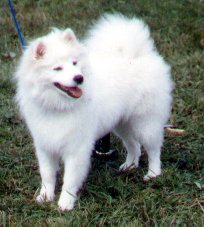![]() The American Eskimo
Dog, nicknamed Eskie, belongs to the Spitz family of dogs (also
known as Nordic breeds). The "White Spitz dog," was popular
in the coastal regions of Germany and the province of Pomerania. Around
the 1700's, the White Spitz dog became quite popular in British society,
and Queen Charlotte acquired several White Spitz dogs weighing between
20 to 30 pounds from Pomerania. (The German's disapproved of the erroneous
term "Pomeranian" being used to describe the White Spitz dog, and these
were not the same dog we know today as the Pomeranian.)
The American Eskimo
Dog, nicknamed Eskie, belongs to the Spitz family of dogs (also
known as Nordic breeds). The "White Spitz dog," was popular
in the coastal regions of Germany and the province of Pomerania. Around
the 1700's, the White Spitz dog became quite popular in British society,
and Queen Charlotte acquired several White Spitz dogs weighing between
20 to 30 pounds from Pomerania. (The German's disapproved of the erroneous
term "Pomeranian" being used to describe the White Spitz dog, and these
were not the same dog we know today as the Pomeranian.)
![]() The United Kennel Club
began registering the American Eskimo in 1913. In 1985 the American Eskimo
Dog of America was formed for the purpose of American Kennel Club recognition
for the breed. The American Eskimo Dog was fully recognized by the American
Kennel Club, July 1, 1995.
The United Kennel Club
began registering the American Eskimo in 1913. In 1985 the American Eskimo
Dog of America was formed for the purpose of American Kennel Club recognition
for the breed. The American Eskimo Dog was fully recognized by the American
Kennel Club, July 1, 1995.
![]()
![]() The American
Eskimo Dog is intelligent, alert and friendly, although slightly conservative.
At home it is an excellent watchdog, very protective of its home and family,
and will sound a warning bark to announce the arrival of any stranger.
The American Eskimo bonds closely with his family and considers them his
property. The Eskie is initially mistrustful around strangers -- he lives
to please and protect his family -- so does not go to strangers readily.
The American
Eskimo Dog is intelligent, alert and friendly, although slightly conservative.
At home it is an excellent watchdog, very protective of its home and family,
and will sound a warning bark to announce the arrival of any stranger.
The American Eskimo bonds closely with his family and considers them his
property. The Eskie is initially mistrustful around strangers -- he lives
to please and protect his family -- so does not go to strangers readily.
![]() The American
Eskimo is a medium to small size dog, with a thick, snow white coat and
a happy, smiling face. The Eskie may have a biscuit cream coloring, as
well. It's ears are triangular shaped and stand erect, and the richly
plumed tail is carried loosely on the back.
The American
Eskimo is a medium to small size dog, with a thick, snow white coat and
a happy, smiling face. The Eskie may have a biscuit cream coloring, as
well. It's ears are triangular shaped and stand erect, and the richly
plumed tail is carried loosely on the back.
![]() The coat
is a stand-off, double coat consisting of a dense undercoat and a longer
coat of guard hair growing through it to form the outer coat, the coat
itself is straight, with no curl or wave.
The coat
is a stand-off, double coat consisting of a dense undercoat and a longer
coat of guard hair growing through it to form the outer coat, the coat
itself is straight, with no curl or wave.

![]() The Eskie's
expression is keen, intelligent, and alert, and its eyes are slightly
oval. The American Eskimo Dog learns new tasks quickly and is eager to
please, which may be why the breed was used widely in Circuses and Rodeos.
The Eskie has been known to perform in the Barnum and Bailey Circus.
The Eskie's
expression is keen, intelligent, and alert, and its eyes are slightly
oval. The American Eskimo Dog learns new tasks quickly and is eager to
please, which may be why the breed was used widely in Circuses and Rodeos.
The Eskie has been known to perform in the Barnum and Bailey Circus.
![]()
![]() In general,
the American Eskimo is a very healthy breed of dog. However, there are
some occasional genetic problems which are of concern to breeders and
owners of American Eskimos.
In general,
the American Eskimo is a very healthy breed of dog. However, there are
some occasional genetic problems which are of concern to breeders and
owners of American Eskimos.
- Progressive Retinal Atrophy (PRA), refers to a group of inherited retinal disorders that cause blindness in dogs. PRA is found in most breeds of purebred dogs, as well as in mixed-breed dogs.
- Canine Hip Dysplasia (CHD), afflicts millions of dogs each year and can result in debilitating degenerative joint disease of the hip.
- Legg-Calve-Perthes Disease, a
deterioration of the head of the femur (thighbone) due to insufficient blood supply. As a result of the insufficient blood supply the head of the femur begins to die and disintegrate.
![]()